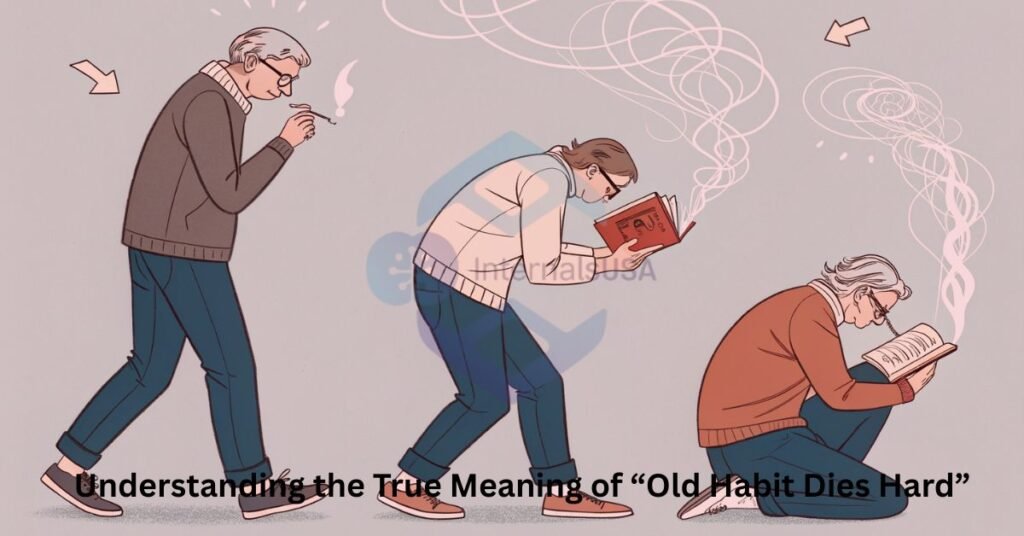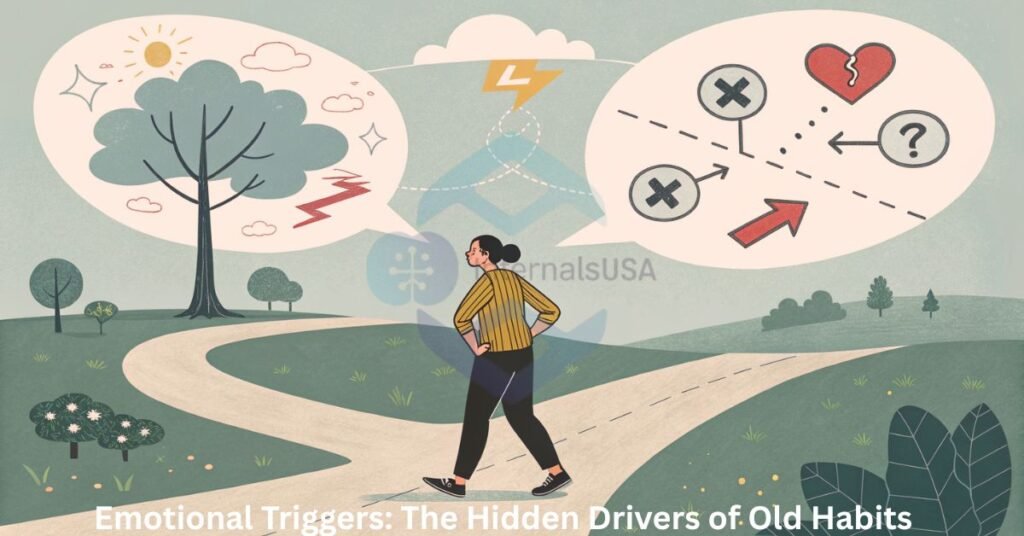Old Habit Dies Hard – The Psychology, Process & Power of Changing Behavior
“Old habit dies hard” is a time-tested phrase that reflects the challenge of breaking deeply rooted behaviors. This comprehensive guide explores why bad habits are difficult to change, how they’re formed in the brain, and practical strategies to replace them with healthier routines. From the psychological attachment and habit loop to mindfulness and environmental redesign, we unpack every aspect that keeps habits alive and how to dismantle them effectively.
Learn how consistency, self-awareness, emotional intelligence, and behavioral nudges can transform long-standing routines. Whether you’re battling smoking, procrastination, overeating, or negativity, this SEO-friendly and user-friendly article offers actionable insights and real-world examples. With 5 FAQs and expert-backed advice, you’ll be empowered to take the first step toward change. Discover why old habit dies hard and how it can still be overcome.
Introduction: Why “Old Habit Dies Hard” Still Rings True
The proverb “old habit dies hard” carries weight for a reason. Habits good or bad shape our daily lives, influence our decisions, and affect our physical and mental well-being. But once ingrained, these routines can feel impossible to let go of, no matter how badly we want to change. Why is that? Whether it’s biting nails, procrastinating, staying up late, overthinking, or emotional eating, habits are tied to our emotional core and neurological pathways.
While change is difficult, it’s not impossible. Understanding the underlying forces behind habits is the first step to rewiring them. In this article, we’ll explore how habits form, why they persist, and how to overcome even the most deeply entrenched ones because old habit dies hard, but not forever.
Understanding the True Meaning of “Old Habit Dies Hard”

This timeless proverb highlights the persistent nature of deeply ingrained behaviors. It reflects the psychological and neurological resistance to change once a habit is rooted. In this section, we break down the phrase and connect it to modern behavioral science, giving readers a foundational understanding of why some habits are so hard to change.
The Neuroscience Behind Habit Formation
Understanding how habits are formed in the brain helps explain why they’re hard to break. Most habits start in the basal ganglia, a region responsible for routine behaviors and motor control.
The Habit Loop
According to Charles Duhigg’s famous model, habits follow a three-part loop:
Cue – A trigger that signals the brain to go into automatic mode.
Routine – The behavior or action itself.
Reward – The brain receives a pleasurable outcome, reinforcing the cycle.
Once this loop is repeated often enough, it becomes automatic, making the habit feel almost involuntary.
The Science of Habit Formation: Why Change Is Hard
Habits are formed in the brain’s basal ganglia, an area responsible for routine actions and subconscious behavior. This heading introduces readers to the biological and psychological mechanisms like the cue-routine-reward loop that make old habits automatic and difficult to undo.
Emotional Triggers: The Hidden Drivers of Old Habits

Many habits are responses to emotional states like stress, anxiety, or boredom. This section explains how emotional triggers lead to habitual behaviors, and why identifying these emotions is crucial to breaking the cycle.
Why Old Habit Dies Hard: Psychological and Emotional Ties
Comfort and Familiarity
Old habits offer a sense of stability. Even if they’re harmful, they feel “safe” because they’re predictable. This psychological comfort keeps people repeating them.
Emotional Dependency
Habits often develop as coping mechanisms for stress, anxiety, or sadness. Smoking, stress eating, or even scrolling social media may temporarily soothe unpleasant feelings.
Social Reinforcement
If your environment reinforces certain behaviors like drinking socially or gossiping it becomes harder to detach. Your surroundings shape your choices.
4. Lack of Awareness
Many people repeat bad habits unconsciously. Without mindfulness, these behaviors remain undetected and unchallenged.
Environmental Influence: How Your Surroundings Reinforce Habits
The people, places, and tools around you can either support or sabotage your habit change. This heading explores how your environment acts as a cue and how redesigning your space can disrupt unwanted patterns.
How Long Does It Really Take to Break a Habit?
Contrary to the myth of “21 days,” studies show it can take anywhere from 18 to 254 days to truly break or form a habit. It depends on the habit’s complexity and the individual’s consistency and mindset.
The Role of Neuroplasticity
The brain’s ability to rewire itself neuroplasticity makes change possible. With sustained repetition of a new behavior, the brain forms new neural pathways, weakening the old ones.
Step-by-Step Guide to Break an Old Habit
Even though old habit dies hard, following a proven strategy can help.
Awareness: Identify the Habit and Its Trigger
Keep a habit journal. What causes the behavior? Stress? Boredom? Peer influence? This step is critical for breaking automaticity.
Interrupt the Cue-Behavior Loop
Change your environment or introduce friction. For example, if you tend to scroll your phone before sleeping, leave it in another room.
Replace the Habit with a Positive One
Instead of removing the behavior altogether, replace it. For instance, meditate for 5 minutes instead of reaching for a cigarette.
Start Small and Build Momentum
Don’t aim for drastic change overnight. Break it into micro-goals. If you want to stop snacking at night, begin by substituting one snack with a healthy drink.
Use Accountability Tools
Track your progress using apps, journals, or support groups. Share your goals with someone you trust.
Reward Yourself for Small Wins
Behavior sticks when it’s reinforced. Set milestones and celebrate them.
Real-Life Examples of Habit Transformation
| Old Habit | New Habit |
|---|---|
| Procrastination | Time-blocking and Pomodoro technique |
| Smoking | Deep breathing or chewing gum |
| Overeating | Mindful eating and smaller portions |
| Late-night screen time | Reading a physical book before bed |
| Negative self-talk | Practicing daily affirmations |
Each of these examples proves that although old habit dies hard, transformation is absolutely possible.
The Role of Environment in Habit Change
Your environment is either a trigger or a shield. Redesigning your surroundings can drastically improve your success in breaking habits.
Practical Tips:
- Remove temptations from sight.
- Make good behaviors more accessible (e.g., keep a water bottle nearby).
- Surround yourself with people who reflect the lifestyle you want.
Mindfulness and Self-Awareness: Game Changers in Habit Breaking

Practicing mindfulness enhances your awareness of automatic behaviors. This mental clarity allows you to observe without judgment and choose better responses.
Benefits of Mindfulness:
- Recognize emotional triggers before reacting
- Stay present during decision-making moments
- Improve emotional regulation and patience
Try apps like Headspace or Calm to begin practicing mindfulness if you’re new to the concept.
Habit Stacking: A Smart Strategy
Habit stacking is pairing a new behavior with an existing one. For example:
- “After I brush my teeth, I will do 5 push-ups.”
- “After pouring coffee, I’ll list 3 things I’m grateful for.”
This creates mental associations that help the new habit stick.
Dealing with Relapses: Don’t Let One Slip Ruin Progress
Relapses are normal. The key is how you respond to them.
Healthy Mindset
- View a setback as a data point, not failure.
- Reflect: What triggered the relapse?
- Reinforce: How can you be better prepared next time?
Remember: Even if old habit dies hard, you’ve already taken steps most people never take you’re aware and committed.
How to Help Others Break Their Habits
If someone close to you is struggling with a bad habit:
- Avoid judgment or lectures.
- Encourage self-awareness and provide resources.
- Offer accountability without pressure.
- Celebrate their small wins.
Frequently Asked Questions (FAQs)
Why do people say “old habit dies hard”?
Because ingrained habits are neurologically and emotionally rooted. They provide comfort and operate automatically, making them tough to change.
Is it possible to break any habit?
Yes. With awareness, consistency, and supportive strategies, even the hardest habits can be rewired and replaced over time.
What’s the fastest way to replace a bad habit?
Identify the trigger, replace the behavior, and reinforce the new pattern using rewards and repetition. Use habit-stacking and accountability tools for support.
How can mindfulness help in breaking habits?
Mindfulness builds self-awareness, allowing you to observe your thoughts and behaviors without reacting impulsively, giving you more control.
What if I keep relapsing into my bad habit?
Relapse is part of the change process. Learn from it, adjust your strategy, and try again. Change is a journey not a linear path.
Conclusion
Breaking old habits can feel like fighting against yourself. But it’s a fight worth winning. The phrase “old habit dies hard” reflects how behavior becomes embedded in our identity and daily life. However, armed with knowledge, mindfulness, and consistency, you can dismantle even the most stubborn routines. The brain’s neuroplasticity, your power to redesign your environment, the effectiveness of replacement strategies, and the strength of accountability make lasting change more than a dream it makes it achievable.
Final Reminder
Every time you resist an old habit, you weaken its grip. Every time you choose a new behavior, you strengthen your future. Let today be the day you start proving that while old habit dies hard it does die.
Also Read
Middle Aged Men Daily Habits: Build a Stronger, Healthier, and Happier Life
Bad Habit Room: Breaking Free from Destructive Environments
Printable Habit Tracker: Your Simple Guide to Building Better Habits








Leave feedback about this